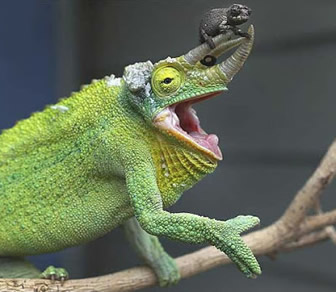Jackson Chameleon Care Sheet
 Jackson chameleons can be around 9-13 inches long and in their natural state are brownish in color when they are born. As they age, they develop into a brighter green. However, when it's stressed or its temperature is too low, Jackson chameleons will turn back into a dark, brown color. Jackson chameleons can be around 9-13 inches long and in their natural state are brownish in color when they are born. As they age, they develop into a brighter green. However, when it's stressed or its temperature is too low, Jackson chameleons will turn back into a dark, brown color.
Male Jackson chameleons have three horns. They resemble a miniature triceratops!
Temperament
Jackson chameleons are extremely territorial so you should never house two in the same habitat!
They also do not like to be handled. They become extremely stressed if they experience either of these two things.
Housing
It's not a good practice to house Jackson Chameleons in a glass aquarium unless you're willing to provide two fans to ensure ventilation. It's best to just stick with some form of mesh enclosure like a Reptarium. The cage should be at least 24 x 24 x 36 but having a taller cage is always a bonus since Jackson Chameleons love to climb.
Substrate
Prevention of bacterial growth inside of the chameleon's habitat is essential to maintaining good health. That means weekly cleaning is required. Lining the bottom with paper towels or newspaper makes cleaning much easier. Some owners do choose to use soil or peat moss but this makes cleaning much more difficult. You can choose to place potted plants on a paper substrate in order to add live plants into your chameleon's habitat. Just be sure not to use wood chips as substrate since chameleons could ingest it and cause health issues.
Furnishings
Provide plenty of vegetation into the habitat to make your Jackson chameleon happy. Just be sure that they are not toxic and then you disinfect any branches. Artificial vines are actually better than real ones. Either way, you want to provide a lot of fun climbing areas and a few practical basking and cooldown areas as well.
Temperature
Jackson's chameleons require a daytime ambient temperature anywhere between 70 and 80 degrees with a basking zone that reaches at least 85 degrees. The nighttime temperature should be between 60 and 70 degrees. So long as your home does not fall below 65 degrees then you are not required to heat the habitat at night. Heating is accomplished with a basking light.
Lighting
Chameleons need two different light sources, a UVB and a basking light. Invest in a good bulb for optimum performance. One of the best choices is a Zoomed Reprisun 5.0. These bulbs need to be replaced every six months. You can also move the habitat outside during optimal temperatures to allow your chameleon to soak as much natural light as possible. However, a Jackson Chameleon should never be exposed to temperatures above 90 degrees.
Humidity and Hydration
Jackson's chameleons require anywhere between a 50% and 80% humidity level. You can increase the humidity by misting the enclosure at least twice a day while monitoring the humidity with a hygrometer. You can even install automatic misting systems. Chameleons rarely drink from a standing water source. They prefer to lick the water droplets from leaves. Set up a drip system that automatically drips water onto leaves.
Feeding
Chameleons are insectivores, meaning that they eat insects. Most people know this but a common mistake that many beginners make is limiting the number of different insects that they feed their chameleon. Jackson chameleons require a wide variety of insects. Some good choices are:
- Crickets
- Mealworms
- Superworms
- Roaches
- Silkworms
- Dried Flies
- Grasshoppers
You should try to get all of your chameleon's food from a pet shop since catching them yourself is risky. You don't know what pesticides they have been exposed to!
Gut load insects by feeding them nutritious foods before offering them to your chameleon. Any kind of greens will work. You may even need to dust them with calcium supplements from time to time. Monitor the insects when you add them to the enclosure though since they can harm your chameleon if left uneaten for expended periods of time.
Gut loading your insects keeps you from having to load supplements into your chameleon. While some people recommend that you provide mineral supplements two-three times a week, if you gut load insects properly then you can vastly reduce this to once a week. For a step-by-step guide to gut loading, check out "Chameleon Care Guide – Keeping & Breeding Healthy Chameleons Made Easy".

|